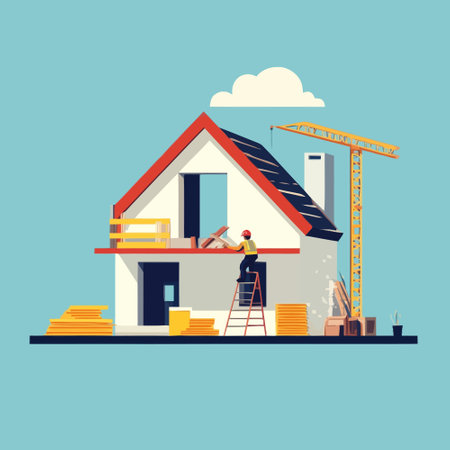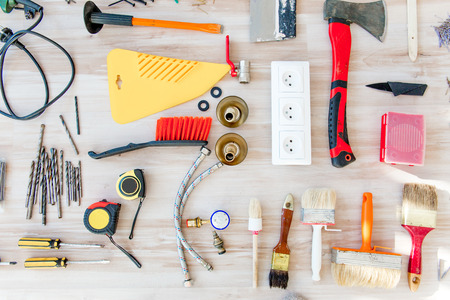1. Thermostat Malfunctions
Your HVAC system relies heavily on your thermostat to regulate the temperature in your home. When your thermostat isnt working correctly, it can throw off the entire system. Whether its not reading the temperature accurately or failing to communicate with your heating and cooling units, a malfunctioning thermostat can lead to discomfort and higher energy bills.
Common Signs of a Faulty Thermostat
| Symptom | Possible Cause |
|---|---|
| HVAC wont turn on or off | No power to thermostat or miswiring |
| Incorrect room temperature readings | Thermostat sensor issues or placement problems |
| Frequent cycling on and off | Faulty thermostat calibration or outdated model |
| Unresponsive controls | Dead batteries or internal failure |
How to Troubleshoot Your Thermostat
Step 1: Check the Power Source
If your thermostat is completely unresponsive, check if it’s receiving power. For battery-operated models, replace the batteries. If it’s hardwired, make sure there’s no tripped breaker or blown fuse.
Step 2: Inspect Settings and Schedule
Sometimes the issue is as simple as incorrect settings. Double-check that the thermostat is set to “heat” or “cool” as needed, and verify that scheduled programs match your daily routine.
Step 3: Clean or Reset the Thermostat
Dirt and dust buildup can affect performance. Gently clean the surface and vents of your thermostat using a soft brush. If issues persist, try resetting it according to the manufacturer’s instructions.
Step 4: Recalibrate or Replace If Necessary
If your thermostat consistently displays the wrong temperature, it may need recalibration—some digital models allow manual adjustment. If it’s an older unit or continues malfunctioning after troubleshooting, replacing it with a smart thermostat could improve both comfort and energy efficiency.
When to Call a Professional
If youve gone through these steps and your HVAC system still isn’t responding properly, it might be time to call in a licensed technician. Issues like faulty wiring or compatibility problems with newer systems should be handled by professionals to ensure safety and proper function.
A well-functioning thermostat is essential for keeping your home comfortable and energy-efficient year-round. Taking the time to troubleshoot common issues can save you money—and keep your HVAC system running smoothly.
2. Dirty or Clogged Filters
One of the most common HVAC issues homeowners face is dirty or clogged air filters. These filters play a critical role in your heating and cooling system—they trap dust, pollen, pet dander, and other airborne particles to keep your indoor air clean and your HVAC system running smoothly.
Why Dirty Filters Are a Problem
When air filters get too dirty, they restrict airflow through the system. This forces your HVAC unit to work harder to circulate air throughout your home, which can lead to higher energy bills, uneven temperatures, and even potential damage to the system over time. Plus, clogged filters cant effectively remove contaminants from the air, lowering your indoor air quality.
Signs Your Filter Needs Replacing
- Increased dust around your home
- Reduced airflow from vents
- Rising energy bills without increased usage
- Your HVAC system running longer than usual
- Allergy symptoms worsening indoors
How Often Should You Change Your Filter?
The frequency depends on several factors, such as the type of filter you use, whether you have pets, and if anyone in the home has allergies or asthma. Heres a general guideline:
| Household Condition | Filter Replacement Frequency |
|---|---|
| No pets or allergies | Every 60–90 days |
| With pets | Every 30–60 days |
| Allergies or asthma present | Every 20–45 days |
| Vacation home (minimal use) | Every 6–12 months |
How to Replace an Air Filter Properly
- Turn off your HVAC system: Always shut off power before removing the filter to ensure safety.
- Locate the filter slot: Most filters are found near the return air duct or blower compartment.
- Select the right size: Check your current filter’s size printed on the frame, or consult your owner’s manual.
- Insert the new filter correctly: Make sure the airflow arrows on the filter point in the correct direction (toward the blower).
- Date it: Write the replacement date on the filter so you can easily track when its due for another change.
A clean filter is one of the easiest and most affordable ways to keep your HVAC system efficient and maintain good indoor air quality. Make it a habit to check your filter monthly—if it looks dirty, its time for a replacement.

3. Refrigerant Leaks
If your air conditioner isn’t cooling like it used to, one of the most common culprits is a refrigerant leak. The refrigerant is what allows your AC system to absorb heat from inside your home and release it outside. When there’s not enough refrigerant, your system has to work harder, leading to poor performance and higher energy bills.
How to Spot a Refrigerant Leak
Refrigerant leaks aren’t always easy to detect without the right tools, but there are some signs you can watch for:
| Signs of a Refrigerant Leak | Description |
|---|---|
| Warm Air From Vents | The AC blows warm or room-temperature air instead of cool air. |
| Hissing or Bubbling Sounds | You might hear these sounds near the indoor or outdoor unit, which could indicate escaping refrigerant. |
| Ice on the Evaporator Coil | A lack of refrigerant can cause coils to freeze up due to insufficient heat absorption. |
| Higher Energy Bills | Your system works harder and longer to cool your home, driving up energy costs. |
| Poor Cooling Performance | Your rooms take much longer to reach the desired temperature—or never do. |
Why Refrigerant Leaks Matter
A refrigerant leak doesn’t just affect comfort—it can also lead to serious damage. Operating your HVAC system with low refrigerant levels can overheat the compressor, which is one of the most expensive components to replace. In addition, leaking refrigerants can be harmful to the environment and may violate EPA regulations if not handled properly.
How Professionals Fix It
This is not a DIY fix. HVAC technicians follow these steps to safely handle refrigerant issues:
- Leak Detection: They use specialized tools like electronic leak detectors or UV dye to pinpoint the exact location of the leak.
- System Repair: Once found, they seal or replace the leaking component—whether it’s a coil, line, or connection point.
- Recharge the System: After repairs, technicians recharge the system with the correct type and amount of refrigerant according to manufacturer specifications.
- System Testing: They test for pressure balance and proper cooling performance before completing the job.
A Quick Tip:
If your system is older and has had multiple leaks, it might be more cost-effective in the long run to consider replacing the unit rather than continuously repairing it.
The best way to prevent future leaks is with regular HVAC maintenance. A professional tune-up at least once a year can catch small issues before they turn into costly repairs.
4. Electrical Issues and Sensor Failures
Electrical problems and faulty sensors are among the most common reasons HVAC systems stop working properly. These issues can affect everything from your thermostat to your system’s ability to turn on or off at the right time. Let’s take a closer look at what causes these problems, how to spot them, and what you can do safely before calling a professional.
Common Electrical Problems in HVAC Systems
HVAC systems depend on electricity to power components like compressors, fans, and thermostats. When something goes wrong electrically, it can cause partial or total system failure.
| Problem | Possible Cause | What You Can Do |
|---|---|---|
| System won’t start | Tripped circuit breaker or blown fuse | Check the electrical panel and reset breakers if needed |
| Frequent short cycling | Loose wiring or faulty capacitor | Tighten visible connections (if safe) or call a technician |
| Burning smell near unit | Overheating motor or wiring issue | Turn off system immediately and contact a pro |
Sensor Malfunctions That Affect HVAC Performance
Your HVAC system uses various sensors to monitor temperature, humidity, and airflow. If a sensor becomes dirty, misaligned, or fails entirely, it can cause your system to behave unpredictably.
Temperature Sensor Issues
The most common sensor problem involves the temperature sensor near the evaporator coil. If its knocked out of place or covered in dust, it might misread room temperatures.
Signs of Sensor Failure:
- The system cycles on and off too frequently
- Rooms feel warmer or cooler than the thermostat setting
- The fan runs constantly without cooling or heating
Safe Troubleshooting Tips:
- Turn off power: Always shut off power at the breaker before inspecting any component.
- Inspect sensor placement: Make sure the sensor is near—but not touching—the evaporator coil.
- Clean gently: Use a soft cloth or compressed air to remove dust buildup around sensors.
- If unsure, call for help: It’s best not to adjust internal wiring unless youre trained to do so.
Tackling minor electrical and sensor issues early can save you from bigger repairs down the line. But always prioritize safety—when in doubt, bring in a licensed HVAC technician.
5. Poor Airflow or Ductwork Problems
Poor airflow and ductwork issues are among the most common HVAC problems homeowners in the U.S. face. When your system isn’t pushing air properly, it can lead to uneven room temperatures, higher energy bills, and a stressed-out HVAC unit that works harder than it should.
What Causes Poor Airflow?
There are several culprits behind poor airflow. Some of the most frequent include:
- Blocked or closed vents: Furniture, rugs, or dust buildup can block supply or return vents.
- Leaky ducts: Cracks or gaps in ductwork allow conditioned air to escape into unconditioned spaces like attics or crawlspaces.
- Dirty filters: A clogged air filter restricts airflow through the system.
- Faulty blower fan: If the blower motor isnt working properly, it cant circulate air effectively.
How to Identify Airflow Issues
If you notice any of the following signs, you might be dealing with poor airflow:
- Certain rooms are consistently hotter or colder than others
- You hear whistling sounds from your vents (a sign of pressure imbalance)
- Your energy bills are rising without a clear reason
- The HVAC system runs longer than usual but doesn’t cool or heat effectively
Solutions to Improve Airflow and Fix Duct Problems
| Problem | DIY Fixes | When to Call a Pro |
|---|---|---|
| Blocked vents | Clear furniture or objects blocking vents; vacuum vent covers regularly | If internal blockage is suspected within the ductwork |
| Leaky ducts | Use foil tape or mastic sealant for small leaks near accessible areas like basements or attics | If leaks are extensive or located in hard-to-reach spots |
| Dirty filters | Replace filters every 1–3 months depending on usage and household conditions (e.g., pets, allergies) | N/A — this is typically a homeowner task |
| Inefficient blower motor | N/A — requires technical skills and testing tools | If airflow is weak despite clean filters and open vents, have a technician inspect the blower motor |
Avoid Future Issues with Regular Maintenance
The best way to prevent airflow issues is through consistent maintenance. Schedule annual HVAC tune-ups, inspect your ductwork periodically, and always keep vents unblocked. These simple habits go a long way in keeping your home comfortable and your energy bills under control.

